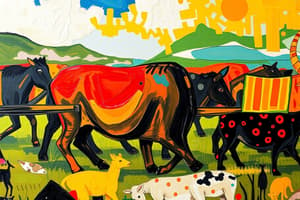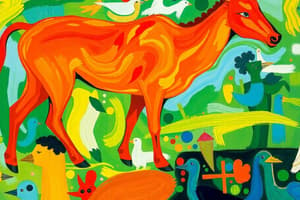Podcast
Questions and Answers
What is the biological surplus?
What is the biological surplus?
- The maximum population that can be sustained in a specific environment
- The movement of non-native species into a new region
- When there are more organisms in a population than the ecosystem can sustain (correct)
- A point in an ecosystem when all populations reach a point of little or no change
What is carrying capacity?
What is carrying capacity?
The maximum population that can be sustained in a specific environment.
What defines a climax community?
What defines a climax community?
A point in an ecosystem when all populations reach a point of little or no change.
What is the death rate?
What is the death rate?
What is emigration?
What is emigration?
What is immigration?
What is immigration?
What is a limiting factor?
What is a limiting factor?
What does peak phenomenon refer to?
What does peak phenomenon refer to?
Define population dynamics.
Define population dynamics.
What is primary succession?
What is primary succession?
What is secondary succession?
What is secondary succession?
What is the sigmoid phenomenon?
What is the sigmoid phenomenon?
How does a decrease in sea ice affect polar bears?
How does a decrease in sea ice affect polar bears?
What are some examples of limiting factors?
What are some examples of limiting factors?
How do sun, water, and land affect an ecosystem's carrying capacity?
How do sun, water, and land affect an ecosystem's carrying capacity?
Describe the differences between primary and secondary succession.
Describe the differences between primary and secondary succession.
Flashcards are hidden until you start studying
Study Notes
Key Concepts in Population Dynamics
- Biological Surplus: Occurs when a population exceeds the ecosystem’s sustainable limits, leading to potential resource shortages and migrations.
- Carrying Capacity: The maximum size of a population that a specific environment can support based on available resources.
- Climax Community: A stable ecosystem where species populations remain relatively unchanged over time.
- Death Rate: The measurement of mortality within a population, expressed as the number of deaths per 1,000 individuals.
- Emigration: The process of leaving one's natural habitat or region to settle in another area.
- Immigration: The arrival of non-native species into a new area, which can impact local ecosystems.
- Limiting Factor: Any element that restricts population growth, whether it be food availability, predators, or environmental conditions.
Population Growth Phenomena
- Peak Phenomenon: A rapid population increase not constrained by typical birth and death rates, followed by a collapse when resources become scarce.
- Sigmoid Phenomenon: Represented by an initial rapid growth phase followed by stabilization when resources are limited, resulting in a population that fluctuates around the carrying capacity.
Succession in Ecosystems
- Primary Succession: The colonization of a lifeless environment by living organisms, starting from scratch (e.g., after a volcanic eruption).
- Secondary Succession: The re-establishment of an ecosystem after a disturbance, such as a fire, resulting in faster recovery compared to primary succession.
Ecological Dynamics and Interactions
- Influence of Food Resources: Changes in the availability of food, such as the Balsam fir trees on Isle Royale, can significantly affect species populations like moose and wolves.
- Tracking Carrying Capacity: Ecologists study long-term population data to determine the ecosystem's ability to support specific species, considering factors like food and habitat availability.
Migration and Species Interaction
- Impacts of Emigration and Immigration: Population movement can be beneficial or harmful; for example, a sudden influx of predators like coyotes can decrease local herbivore populations, affecting the entire ecosystem balance.
- Polar Bear Hunting Challenges: Reduced sea ice limits polar bears' hunting effectiveness, making it harder to catch seals as they can easily escape in open water.
Factors Affecting Ecosystems
- Limiting Factors: Biotic (e.g., food resources) and abiotic factors (e.g., water availability, sunlight) can regulate population growth and overall ecosystem health.
- Seasonal Changes: Variations in environmental conditions, such as sunlight and water levels, directly impact an ecosystem's carrying capacity and can force species migration.
Characteristics of Population Patterns
- Sigmoid Growth: Initially rapid population growth, followed by a plateau as resources become limited, indicating the carrying capacity.
- Peak Growth: Characterized by a significant boom in population followed by a sharp decline when resources are depleted, highlighting the instability without resource management.
Studying That Suits You
Use AI to generate personalized quizzes and flashcards to suit your learning preferences.




